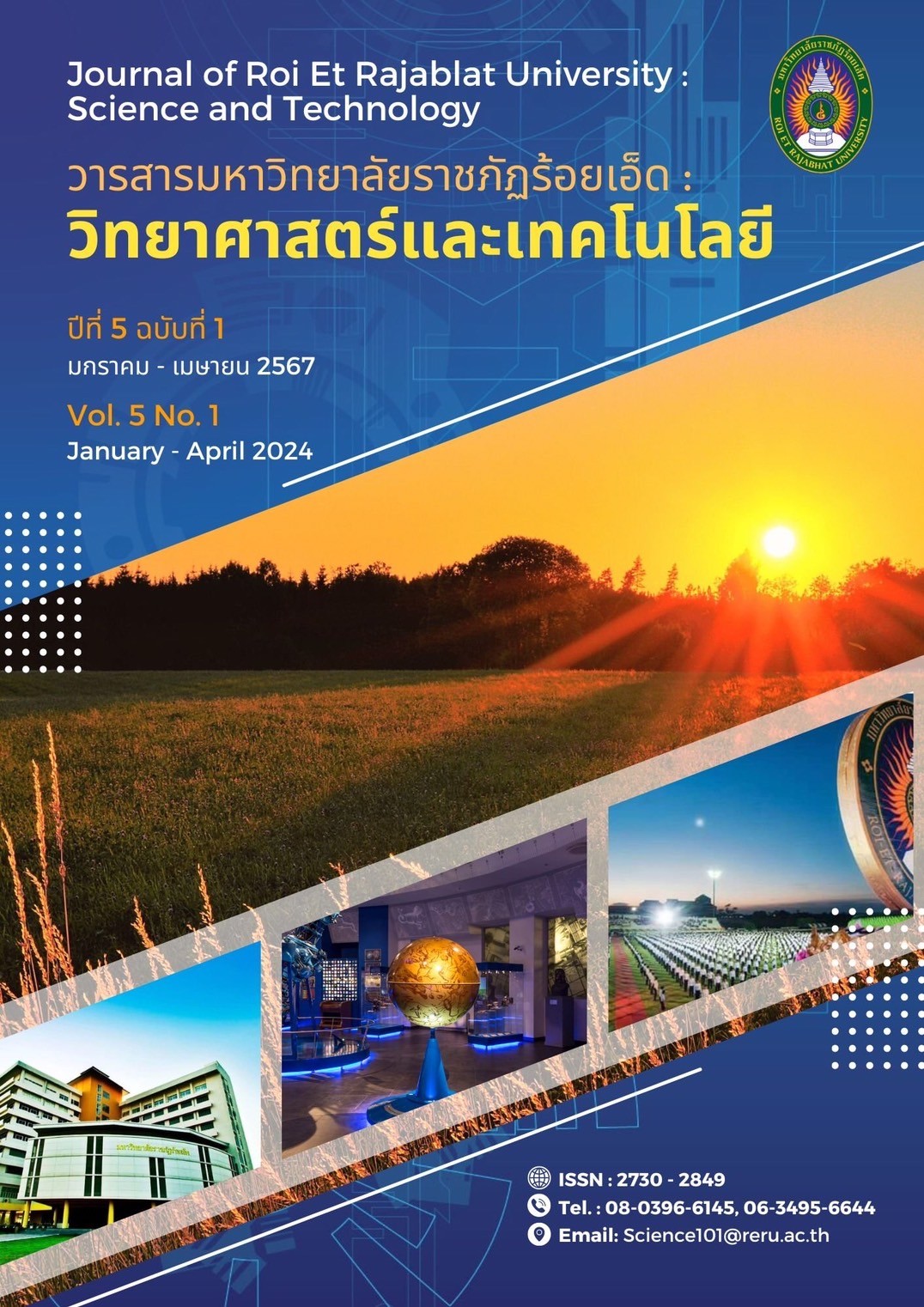ผลของการทำแห้งด้วยอุณหภูมิที่แตกต่างกันต่อสารประกอบฟีนอลิกและความสามารถ ในการต้านอนุมูลอิสระของมะก่อ
บทคัดย่อ
งานวิจัยนี้มีวัตถุประสงค์เพื่อศึกษาผลของการทำแห้งด้วยอุณหภูมิที่แตกต่างกันต่อการเปลี่ยนแปลงของกิจกรรมการต้านอนุมูลอิสระ และสารออกฤทธิ์ทางชีวภาพของมะก่อ (Lithocarpus ceriferus) โดยตัวอย่างมะก่อทำแห้งด้วยวิธีอบลมร้อนที่อุณหภูมิ 40 องศาเซลเซียส (ºC) และ 80 ºC พบว่า ปริมาณสารประกอบฟีนอลิกทั้งหมด (Total phenolic content) อยู่ในช่วง 24.62-42.38 mg GAE/g db และปริมาณฟลาโวนอยด์ทั้งหมด (Total flavonoid content) อยู่ในช่วง 0.89-1.16 mg RE/g db การศึกษาผลของการทำแห้งมะก่อที่แตกต่างกัน พบว่า มีชนิดและปริมาณกรดฟีนอลิค จำนวน 11 ชนิด ได้แก่ gallic acid, protocatechuic acid, p-hydroxybenzoic acid, vanillic acid, chlorogenic acid, caffeic acid, syringic acid,p-coumaric acid, ferulic acid sinapic acid และ gentisic acid ตามลำดับ และมีค่าปริมาณกรดฟีนอลิครวม เท่ากับ 1,115.47 µg/g db ผลการวิเคราะห์ชนิดและปริมาณของสารประกอบฟลาโวนอยด์ พบว่ามีชนิดและปริมาณฟลาโวนอยด์ 4 ชนิด ได้แก่ rutin, myricetin, quercetin และ apigenin ตามลำดับ มีค่าฟลาโวนอยด์รวม เท่ากับ 367.48 µg/g db อย่างไรก็ตาม ไม่พบ kaempferol ในตัวอย่างที่ทำการศึกษาฤทธิ์การต้านอนุมูลอิสระ พบว่า มีฤทธิ์การต้านอนุมูลอิสระโดยวิธี FRAP อยู่ในช่วง 18.20- 27.81 µmol FeSO4/g db และฤทธิ์การต้านอนุมูลอิสระด้วย วิธี DPPH radical scavenging activity อยู่ในช่วง 7.30- 9.03 mg Trolox/g db ตามลำดับ การอบแห้งที่อุณหภูมิที่แตกต่างกันมีผลต่อปริมาณองค์ประกอบทางเคมีที่แตกต่างกัน โดยการใช้อุณหภูมิสูงในการทำแห้งส่งผลต่อปริมาณสารออกฤทธิ์ทางชีวภาพ และกิจกรรมการต้านอนุมูลอิสระในผลิตภัณฑ์มะก่อ
เอกสารอ้างอิง
Hongwiwat, N. & Hongwiwat, T. (2007). Makor in 111 types of fruits: The value of food and eating. Bangkok. Sangdad.
Chumroenphat, T., Somboonwatthanakul, I., Saensouk, S. & Siriamornpun, S. (2019). The diversity of biologically active compounds in the rhizomes of recently discovered Zingiberaceae plants native to North Eastern Thailand. Pharmacognosy Journal. 11 (5),1014-1022. https://doi:10.5530/pj.2019.11.160
Chumroenphat, T., Somboonwatthanakul, I., Saensouk, S. & Siriamornpun, S. (2020). Changes in curcuminoids and chemical components of turmeric (Curcuma longa L.) under freeze-drying and low-temperature drying methods. Food Chemistry. 339, 128121. https://doi: 10.1016/j.foodchem.2020.128121
Pereira-Lorenzo, S., Ramos-Cabrer, A.M., Díaz-Hernández, M., Ciordia-Ara, M. & Ríos-Mesa, D. (2006). Chemical composition of chestnut cultivars from Spain. Scientia Horticulturae. 107, 306–314. https://doi.org/10.1016/j.scienta.2005.08.008
Siriamornpun, S. & Kaewseejan, N. (2017). Quality, bioactive compounds and antioxidant capacity of
selected climacteric fruits with relation to their maturity. Scientia Horticulturae, 221, 33-42. https://doi.org/10.1016/j.scienta.2017.04.020
Wanyo, P., Meeso, N. & Siriamornpun, S. (2014). Effects of different treatments on the antioxidant properties and phenolic compounds of rice bran and rice husk. Food Chemistry. 157, 457–463. https://doi: 10.1016/j.foodchem.2014.02.061
Yu, J.M., Nam, M. & Kim, M-S. (2022). Metabolite profiling of chestnut (Castanea crenata) according to origin and harvest time using 1H NMR spectroscopy. Foods. 11, 1325. https://doi.org/10.3390/foods11091325
ดาวน์โหลด
เผยแพร่แล้ว
รูปแบบการอ้างอิง
ฉบับ
ประเภทบทความ
สัญญาอนุญาต
ลิขสิทธิ์ (c) 2024 คณะศิลปศาสตร์และวิทยาศาสตร์ มหาวิทยาลัยราชภัฏร้อยเอ็ด

อนุญาตภายใต้เงื่อนไข Creative Commons Attribution-NonCommercial-NoDerivatives 4.0 International License.
บทความที่ได้รับการตีพิมพ์เป็นลิขสิทธิ์ของคณะศิลปศาสตร์และวิทยาศาสตร์ มหาวิทยาลัยราชภัฏร้อยเอ็ด
ข้อความที่ปรากฏในบทความแต่ละเรื่องในวารสารวิชาการเล่มนี้เป็นความคิดเห็นส่วนตัวของผู้เขียนแต่ละท่านไม่เกี่ยวข้องกับมหาวิทยาลัยราชภัฎร้อยเอ็ด และคณาจารย์ท่านอื่นๆในมหาวิทยาลัยฯ แต่อย่างใด ความรับผิดชอบองค์ประกอบทั้งหมดของบทความแต่ละเรื่องเป็นของผู้เขียนแต่ละท่าน หากมีความผิดพลาดใดๆ ผู้เขียนแต่ละท่านจะรับผิดชอบบทความของตนเองแต่ผู้เดียว






